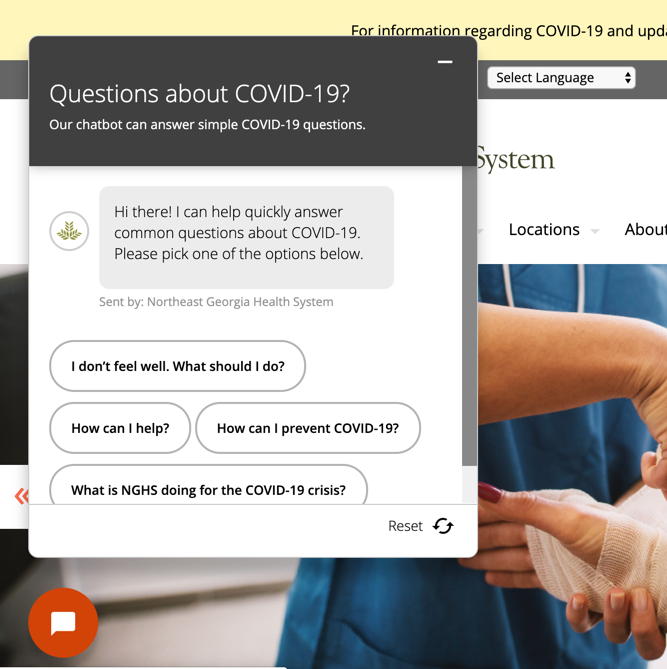The Rise of Chatbots: Understanding Their Growing Place in Healthcare
It sounds a bit like something out of a sci-fi movie — “bots” playing a role in healthcare. But it’s actually a growing reality for many healthcare organizations, as chatbots emerge as a way to communicate with patients.
Chatbots have been growing in popularity among healthcare marketers for a while now, but the trend has picked up force during the COVID-19 pandemic. With healthcare practices facing so many questions and concerns from patients, they’re looking for viable ways to expedite communication while still providing the information patients need.
That’s where chatbots are becoming increasingly relevant. Let’s examine how chatbots are being used now — and the role they may play in the future.
Chatbots in the Age of COVID-19
While chatbots have been around in some form in healthcare for a few years now, the pandemic is shining a light on the trend. Most of us are facing questions and concerns about some aspect of life right now, from our finances to our ability to navigate the community safely.
Those questions and concerns are magnified when they relate to a healthcare issue. For those who are in need of medical care during this time, it’s only natural to need guidance and information related to next steps, processes and procedures, and personal safety.
This coincides with a time period where many healthcare practices are working with a reduced workforce. Organizations are looking for ways to ensure patients get the information they need, while also freeing up employees to handle other responsibilities.
Increasingly, healthcare practices are seeing chatbots as an effective tool for communicating with patients and getting them essential information. Chatbots are a software program that can be used to have a “conversation” of sorts, and they can be programmed with commonly asked questions and answers.
Take Northeast Georgia Health System, for example. If you visit their website, you will quickly notice a red conversation bubble on the screen, asking if you have COVID-19 questions. Clicking the bubble connects you with the chatbot, prompting you with commonly asked questions and then pointing you quickly toward the answer.
This provides patients with the information they’re seeking in many cases, without having to parse through pages of the website on their own or seek further information.
The Role Chatbots May Play in the Future
Chatbots have been around in other industries for many years, but because healthcare often has a slow adoption rate when it comes to technology, the trend was slower to make an imprint among medical practices. That changed when COVID-19 emerged. Healthcare organizations — and healthcare marketers specifically — were forced to quickly adapt to many changes and the evolving needs of patients and the community.
Because chatbots provide a mechanism to answer frequently asked questions in a user-friendly, interactive format, they’ve carved out a place in healthcare’s “new normal.” In today’s world, people are looking for the quickest way from point A to point B, and they want it at the click of a fingertip.
Chatbots can meet that need, helping patients navigate healthcare websites and allowing patients to play an active role in their own healthcare experience. They’re even relatively simple to implement. In fact, as part of an effort to help healthcare organizations navigate the COVID-19 pandemic, Google introduced free chatbot templates.
Chatbots can even be integrated effectively with appointment schedulers, allowing for an easier experience in making in-person or telemedicine appointments.
But it’s important to proceed with some caveats in mind, too. While chatbots are a mechanism to communicate information with patients, they cannot be the only mechanism. They are not a substitute for a wholesale effort to communicate with patients; some information still needs to be written out long-form and placed on a website, and some information needs to be communicated from person to person.
Consider chatbots as a piece of the puzzle when it comes to effective healthcare marketing and communications. They are a bridge to get people to the information they need quickly, and when done effectively, they can make the patient experience more seamless.
At Full Media, our mission is to impact our world positively. If there’s a way we can help your healthcare organization better communicate with your community during the COVID-19 pandemic and beyond, contact us today.

Rachael develops and executes visionary strategy for Full Media, serves as the in-house subject matter expert in healthcare Internet marketing, and identifies ongoing opportunities to add value to healthcare organizations through innovation and team member development.
She has a wide array of expertise in developing marketing strategies for healthcare clients and different medical specialties, with specific experience in developing strategies for MD referrals, YouTube TrueView campaigns and building reports to compare the effectiveness of traditional media to digital media.
Read Full Bio
